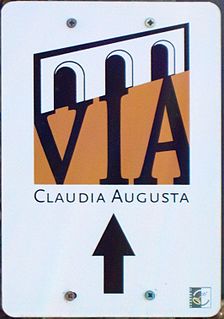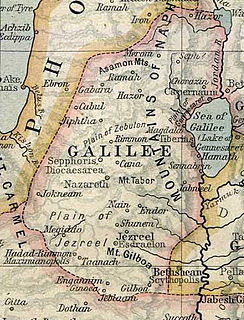 W
WThe Pont Ambroix or Pont d'Ambrussum was a 1st-century BC Roman bridge in the south of France which was part of the Via Domitia. It crossed the Vidourle at Ambrussum, between today's Gallargues-le-Montueux in the Gard department and Villetelle in the Hérault department.
 W
WAugusta Raurica is a Roman archaeological site and an open-air museum in Switzerland located on the south bank of the Rhine river about 20 km east of Basel near the villages of Augst and Kaiseraugst. It is the site of the oldest known Roman colony on the Rhine.
 W
WAugustan and Julio-Claudian art is the artistic production that took place in the Roman Empire under the reign of Augustus and the Julio-Claudian dynasty, lasting from 44 BC to 69 AD. At that time Roman art developed towards a serene "neoclassicism", which reflected the political aims of Augustus and the Pax Romana, aimed at building a solid and idealized image of the empire.
 W
WBithynia and Pontus was the name of a province of the Roman Empire on the Black Sea coast of Anatolia (Turkey). It was formed during the late Roman Republic by the amalgamation of the former kingdoms of Bithynia and Pontus. The amalgamation was part of a wider conquest of Anatolia and its reduction to Roman provinces.
 W
WAfter the destruction of Punic Carthage in 146 BC, a new city of Carthage was built on the same land. By the 3rd century, Carthage developed into one of the largest cities of the Roman Empire, with a population of several hundred thousand. It was the center of the Roman province of Africa, which was a major breadbasket of the empire. Carthage briefly became the capital of a usurper, Domitius Alexander, in 308–311. Conquered by the Vandals in 439, Carthage served as the capital of the Vandal Kingdom for a century. Re-conquered into the Eastern Roman Empire in 533/4, it continued to serve as an Eastern Roman regional center, as the seat of the praetorian prefecture of Africa. The city was sacked and destroyed by Arabs after the Battle of Carthage in 698 to prevent it from being reconquered by the Byzantine Empire. It remained occupied by a garrison during the Muslim period and was used as a fort by the Muslims until the Hafsid period when it was taken by Crusaders with its defenders killed during the Eighth Crusade. The Hafsids decided to destroy its defenses so it couldn't be used as a base by a hostile power again. Roman Carthage was used as a source to provide building materials for Kairouan and Tunis in the 8th century.
 W
WCilicia was an early Roman province, located on what is today the southern (Mediterranean) coast of Turkey. Cilicia was annexed to the Roman Republic in 64 BC by Pompey, as a consequence of its military presence in the east, after pursuing victory in the Third Mithridatic War. It was subdivided by Diocletian in around 297, and it remained under Roman rule for several centuries, until falling to the Islamic conquests.
 W
WCisalpine Gaul was the part of Italy inhabited by Celts (Gauls) during the 4th and 3rd centuries BC. After its conquest by the Roman Republic in the 220s BC it was considered geographically part of Roman Italy but remained administratively separated. It was a Roman province from c. 81 BC until 42 BC, when it was de jure merged into Roman Italy as indicated in Caesar's unpublished acts. Cisalpine means "on the hither side of the Alps", as opposed to Transalpine Gaul.
 W
WClassical Latin is the form of Latin language recognized as a standard by writers of the late Roman Republic and early Roman Empire. It was used from 75 BC-3rd century AD when it developed into Late Latin. In some later periods, it was regarded as good or proper Latin, with following versions viewed as debased, degenerate, vulgar, or corrupted. The word Latin is now understood by default to mean "Classical Latin"; for example, modern Latin textbooks almost exclusively teach Classical Latin.
 W
WThe Via Claudia Augusta is an ancient Roman road, which linked the valley of the Po River with Rhaetia across the Alps.
 W
WThe Crimean Peninsula was under partial control of the Roman Empire during the period of 47 BC to c. 340 AD. The territory under Roman control mostly coincided with the Bosporan Kingdom . Rome lost its influence in Taurica in the mid third century AD, when substantial parts of the peninsula fell to the Goths, but at least nominally the kingdom survived until the 340s AD. Byzantium, the eastern continuation of the Roman Empire, later regained Crimea under Justinian I. The Byzantine Greeks controlled portions of the peninsula well into the Late Middle Ages.
 W
WThe area of Georgia was under Roman control between the 1st century BC and the 7th century AD. This control varied by time and was intermittent over the kingdoms of Colchis and Iberia in the Caucasus region. These kingdoms roughly correspond to some of the western and eastern parts of modern Georgia.
 W
WLegio III Gallica was a legion of the Imperial Roman army founded around 49 BC by Gaius Julius Caesar for his civil war against the republicans led by Pompey. The cognomen Gallica suggests that recruits were originally from Gaul. The legion was established in Roman Syria, and was still active in Egypt in the early 4th century. The legion's symbol was a bull.
 W
WLegio IV Scythica was a legion of the Imperial Roman army founded c. 42 BC by the general Mark Antony, for his campaign against the Parthian Empire, hence its other cognomen, Parthica. The legion was still active in Syria in the early 5th century.
 W
WLegio V Macedonica was a Roman legion. It was probably originally levied in 43 BC by consul Gaius Vibius Pansa Caetronianus and Gaius Iulius Caesar Octavianus. It was based in the Balkan provinces of Macedonia, Moesia and Dacia. In the Notitia Dignitatum records from beginning of the fifth century, the legion was still stationed in Dacia, with detachments stationed in the east and Egypt.
 W
WLegio X Fretensis was a legion of the Imperial Roman army. It was founded by the young Gaius Octavius in 41/40 BC to fight during the period of civil war that started the dissolution of the Roman Republic. X Fretensis is then recorded to have existed at least until the 410s.
 W
WLegio XI Claudia was a legion of the Imperial Roman army. The legion was levied by Julius Caesar for his campaign against the Nervii. XI Claudia dates back to the two legions recruited by Julius Caesar to invade Gallia in 58 BC, and it existed at least until the early 5th century, guarding lower Danube in Durostorum.
 W
WLegio XIX was a legion of the Imperial Roman army. It was destroyed in 9 AD in the Battle of the Teutoburg Forest. The emblem of the XIXth legion is unknown but was probably the Capricorn like other legions levied by Augustus. The symbol of the legion is unknown, but it was likely the capricorn.
 W
WLegio XV Apollinaris was a legion of the Imperial Roman army. It was recruited by Octavian in 41/40 BC. The emblem of this legion was probably a picture of Apollo, or of one of his holy animals.
 W
WLegio XVII was a legion of the Imperial Roman army. It was founded by Augustus around 41 BC. The legion was destroyed in the Battle of the Teutoburg Forest. The legion's symbol and cognomen are unknown.
 W
WLegio XVIII was a legion of the Imperial Roman army. It was founded ca. 41 BC by the future emperor Augustus. The legion was, along with two others, destroyed in the Battle of Teutoburg Forest. The legion's symbol and cognomen are unknown.
 W
WLegio XXII Deiotariana was a legion of the Imperial Roman army, founded ca. 48 BC and disbanded during the Bar Kokhba revolt of 132–135. Its cognomen comes from Deiotarus, a Celtic king of Galatia. Its emblem is unknown.
 W
WLusitania or Hispania Lusitana was an ancient Iberian Roman province located where modern Portugal and part of western Spain lie. It was named after the Lusitani or Lusitanian people.
 W
WPtolemais was an ancient port city on the Phoenician coast. It was also called Ptolemais in Phoenicia. It was an Ancient bishopric, which became a double Catholic titular see.
 W
WThe Roman circus of Mérida is a ruined Roman circus in Mérida, Spain. Used for chariot racing, it was modelled on the Circus Maximus in Rome and other circus buildings throughout the empire. Measuring more than 400 m in length and 30 m of width, it is one of the best preserved examples of the Roman circus. It could house up to 30,000 spectators.
 W
WThe Roman Forum is an archaeological area in Mérida, Spain. It was the main public area of the Roman city of Emerita Augusta, founded in 25 BC by Emperor Augustus. The city had another forum, the Provincial Forum, built in 50 AD. Together with the other archaeological sites of the city, it was inscribed in the UNESCO World Heritage List in 1993. Mérida, or Emerita Augusta in Latin, was once the capital of the Lusitania imperial province that included most of Portugal as well as the western central portion of Spain. It contains many common places found in a Roman city: buildings such as theaters, temples, forums, and arenas. Mérida’s ruins are mostly still intact, despite the passage of time of approximately 2,000 years. Mérida preserves more important ancient Roman monuments than any other city in Spain
 W
WRoman Syria was an early Roman province annexed to the Roman Republic in 64 BC by Pompey in the Third Mithridatic War following the defeat of King of Armenia Tigranes the Great.
 W
WThe Roman Theatre of Mérida is a construction promoted by the consul Vipsanius Agrippa in the Roman city of Emerita Augusta, capital of Lusitania. It was constructed in the years 16 to 15 B.C.E. One of the most famous and visited landmarks in Spain, the Roman Theatre of Mérida is regarded as a Spanish cultural icon and was chosen as one of the 12 Treasures of Spain.
 W
WVia Agrippa, is any stretch of the network of Roman roads in Gaul that was built by Marcus Vipsanius Agrippa, to whom Octavian entrusted the reorganization of the Gauls. In all, the Romans built 21,000 kilometres (13,000 mi) of roads in Gaul.